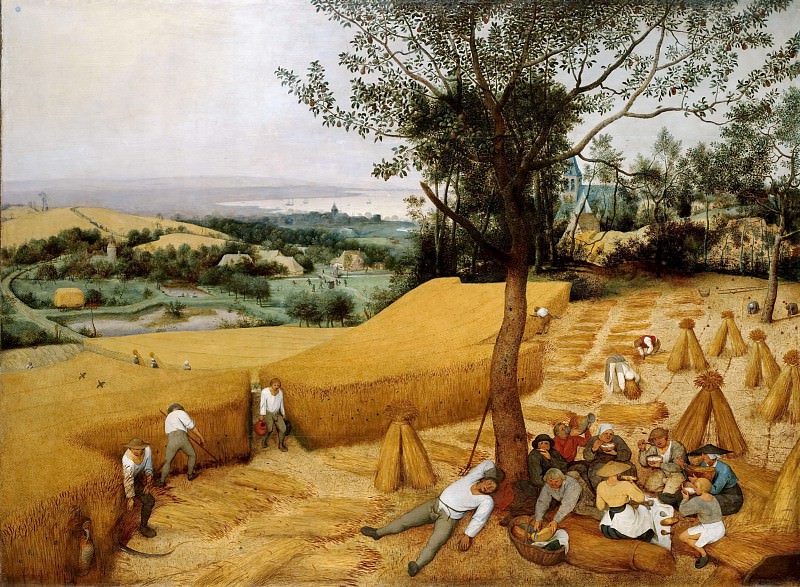The harvesters Pieter Brueghel The Elder (1525-1569)
Pieter Brueghel The Elder – The harvesters
Edit attribution
Download full size: 3700×2711 px (4,4 Mb)
Painter: Pieter Brueghel The Elder
Location: Metropolitan Museum of Arts, New York.
Peter Bruegel the Elder painted the famous painting "Haymaking" in 1565, which is included in the "Seasons" series. He is a great master of the pen who depicts nature and all that goes on around it in a very subtle and kindly way. The subject is dedicated to the summer months: June and July, at a time when the haymaking begins and goes on. The picture is painted in a realistic style, it carries a sense of reality from what you see on the canvas.
Description of Peter Brueghel’s painting "The Haystack"
Peter Bruegel the Elder painted the famous painting "Haymaking" in 1565, which is included in the "Seasons" series. He is a great master of the pen who depicts nature and all that goes on around it in a very subtle and kindly way.
The subject is dedicated to the summer months: June and July, at a time when the haymaking begins and goes on. The picture is painted in a realistic style, it carries a sense of reality from what you see on the canvas. There is an incredible connection between man and nature, their communication is so close that they merge in a single harmony. To achieve life and unity with nature is very difficult, only great masters are able to convey all the feelings, emotions and actions of people.
The main characters are peasants, who are depicted in different variations: men mowing grass, women gathering it into sheaves, another brigade from the shade of a tree dining and resting. People bring a special meaning to the canvas, they are one with nature and at the same time on different poles. Look how harmoniously the peasants fit into the general background of the picture, even though they are all engaged in different activities.
In the foreground sleeps a tired man after his work shift. You can see that he is very tired, because he did not have time to take a comfortable position for sleep. The labor of the working people is in the foreground. The landscape and terrain are stunningly realistic, it seems as if we are there ourselves.
The artist uses warm colors to create the image of nature: yellow field, green grass, blue sky. The main colors in the composition Bruegel still gave people, he clearly conveys it through the peasant’s clothes. Nature awakens, peasants begin to work, it is not for nothing that these two parallels are drawn here. We viewers should think about the meaning of existence and our purpose in this world.
The picture is in the National Gallery in Prague, if you are in those places, be sure to see the painting in reality, you will get a lot of impressions.
Кому понравилось
Пожалуйста, подождите
На эту операцию может потребоваться несколько секунд.
Информация появится в новом окне,
если открытие новых окон не запрещено в настройках вашего браузера.
You need to login
Для работы с коллекциями – пожалуйста, войдите в аккаунт (open in new window).




















COMMENTS: 4 Ответы
Это жатва, а не сенокос!
Сенокос - косьба травы на сено, а также предназначенные для косьбы травы луга и другие места. Косьбы - косами.
Жатва - процесс уборки злаковых культур при помощи серпа или голыми руками. Обычно рожь, пшеницу, ячмень повсюду жали серпом, считалось большим грехом косить пшеницу косой. Если плохую пшеницу нельзя было сжать серпом, её вырывали с корнем.
Поправьте, если ошибаюсь.
в переводе – Жнецы
You cannot comment Why?
The Harvesters by Pieter Bruegel the Elder depicts a rural landscape in the midst of summer harvest. In the foreground and midground, workers are actively engaged in reaping wheat, binding sheaves, and transporting them, illustrating the labor-intensive nature of agricultural work.
To the right, a group of harvesters is taking a break from their labor, gathered under a tree to share a meal and rest. This scene highlights the human element of the harvest, showing them as real people with needs for sustenance and repose. One figure is even depicted sleeping, suggesting the physical exhaustion that comes with the work.
In the background, the painting reveals a broader panorama of a bustling countryside. Rolling hills are dotted with farms, trees, and a body of water, possibly a river or a lake, meeting a hazy horizon. This expansive view emphasizes the scale of human endeavor within the natural world and suggests a prosperous and active rural economy.
The subtexts of the painting are rich and multifaceted:
Overall, The Harvesters is not just a depiction of a rural scene but a profound meditation on human life, labor, and the relationship between humanity and the natural world.